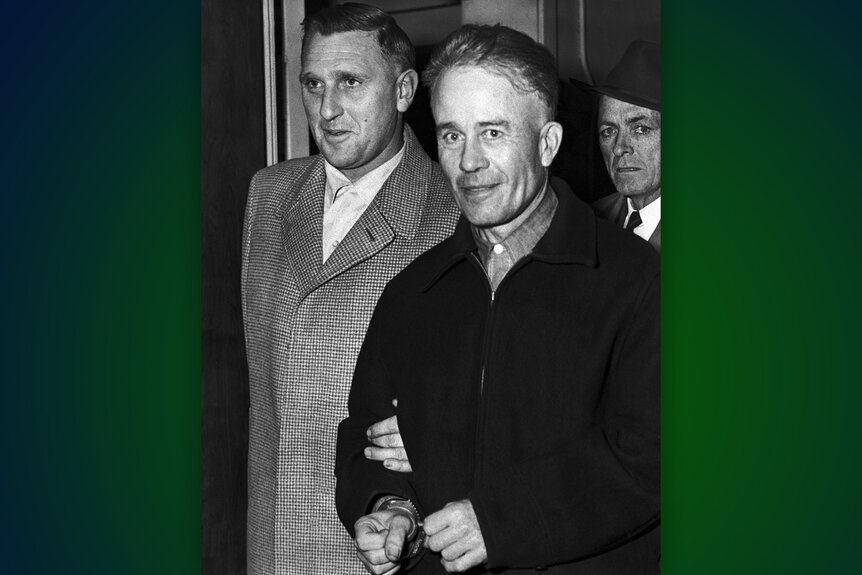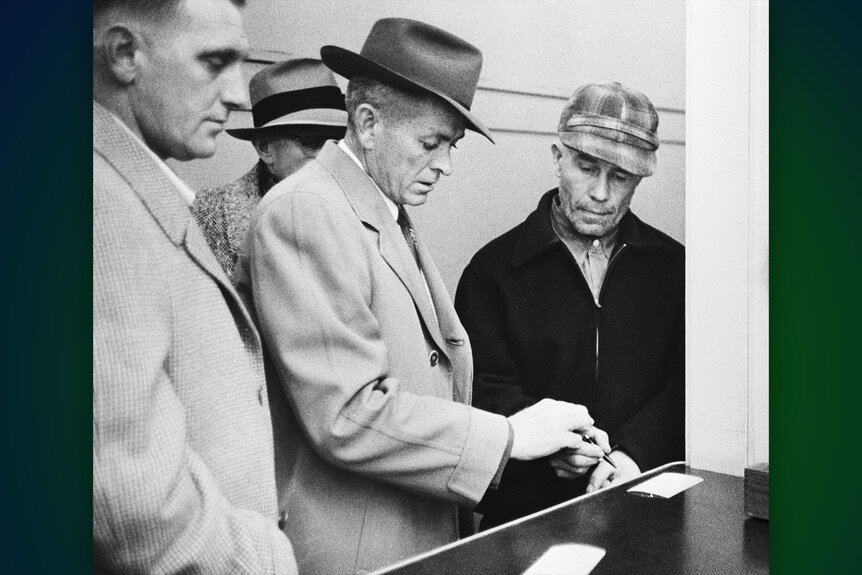Create a free profile to get unlimited access to exclusive videos, breaking news, sweepstakes, and more!
All About Ed Gein, the Serial Killer Who Decorated His Home with Human Skin and Bones
When Ed Gein was suspected of killing a hardware store owner in 1957, cops not only found her decapitated body while searching his Wisconsin farm — but the bones, skin and skulls of other corpses fashioned into household items.

When Ed Gein was suspected of killing a hardware store owner in 1957, authorities not only discovered her decapitated body hung upside down while searching his Plainfield, Wisconsin farm — but the bones, skin and skulls of other corpses fashioned into household items like bowls and bedposts.
The bombshell findings led to the revelation that he’d been robbing graves, and he ultimately confessed to killing two women, as well as digging up bodies and cutting out parts to wear and decorate his home with.
Police believed he may have also been responsible for other murders in the area, but were unable to definitively tie him to those cases.
Gein’s obsession with his mother also drew attention, with the odd relationship and the killer’s penchant for collecting body parts inspiring a host of horror films.
Ed Gein's Childhood and Family Life
As is the case with many serial killers, Gein suffered a tough childhood. Born on Aug. 27, 1906 in La Crosse, Wisconsin as Edward Theodore Gein, his mother Augusta Wilhelmine was verbally abusive, according to Britannica.com, and his father George Philip Gein was an alcoholic.
Despite his mom's abuse towards him, Gein was infatuated with her. Augusta was the dominant one in his parents' relationship, as George was more timid. Augusta was deeply religious and often preached about sins surrounding lust, according to Biography.com.
The family moved to a farm in Plainfield around 1915, with Gein sticking around the property as much as possible and mostly only leaving to go to school. George died in 1940. By then, Gein's obsession with his mother had already held him back from dating and having a social life.
Gein's older brother Henry was disturbed by Gein's relationship with their mother, and brought this up to her at times, according to Britannica.
After their father's death, the brothers worked odd jobs to earn money. One of Gein's jobs was babysitting, according to "Last Book On The Left: Stories of Murder and Mayhem from History's Most Notorious Serial Killers."
In 1944, Gein and Henry were reportedly burning brush on their Plainfield family farm when the fire spread and got out of control. Gein told police that his brother went missing in the fire, but was able to lead them straight to Henry's dead body when they arrived.
Authorities called the death an accident as a result of the fire, despite bruises being found on Henry's head.
Those facts, plus the revelation years later that Gein was a killer, led investigators to later suspect that Gein may have been responsible for his big brother's death.
When Augusta died in 1945, Gein became even more isolated and psychotic. He closed off parts of the home his mom often used, turning them into a shrine, according to Britannica.
Gein also let the rest of the home fall apart rather than upkeep it, and started studying human anatomy, along with medical tests conducted by the Nazis, and fixating on porn, according to All That's Interesting.
What did Ed Gein do?
Gein only confessed to murdering two women, Mary Hogan in 1954, and Bernice Worden in 1957.
Worden, a hardware store owner in Plainfield, disappeared on Nov. 16 of 1957. A trail of blood was left behind that led to the back of the store. She'd been seen with Gein at her shop the night before she vanished. The woman's son, who was a deputy sheriff, suspected Gein, who was taken into custody, according to Biography.
Police then searched the Gein family farm and came across a horrific scene. They discovered Worden's body, which had been shot, decapitated and hung by her ankles. When investigators got a closer look at his home, they found various objects, masks and clothing that he'd made from human body parts.
Bedposts were adorned with skulls, and skulls were also crafted into kitchen utensils and bowls. Cops also found lampshades made of faces and chair upholstery made of skin. Gein later told investigators that he wanted to make a suit made out of women's skin so that he could become his mother, according to All That's Interesting.
During their search of Gein's property after Worden's disappearance, police also found the head of Hogan, the owner of a tavern who had gone missing in 1954.
The Gein home was destroyed by a fire in 1958, and it was never determined what caused it.
RELATED: Jack Unterweger Passed Himself Off As a Reformed Criminal, Then Killed Many More Victims
What was Ed Gein convicted of?
After confessing to killing Worden and Hogan, as well as cutting off body parts from corpses he dug up to make masks and other items to wear, investigators tried to link him to other crimes but were unsuccessful.
Gein was found unfit to stand trial in 1958, after his lawyer entered a plea of not guilty by reason of insanity, according to Biography, and committed to Central State Hospital.
A decade later, in 1968, he was found fit to stand trial and was convicted of Worden's murder that November. He was also found to be insane at the time he committed the killing, and was therefore sent back to Central State Hospital.
In 1974, Gein tried to petition to be released, but that was denied. Years later, he was transferred to the Mendota Mental Health Institute when he fell ill. He died from respiratory issues caused by lung cancer on July 26, 1984 at 77 years old.
Gein was never charged with Hogan's murder, and all the graverobbing crimes, reportedly due to his county not having the budget to investigate all the crimes.
What horror movies are inspired by Ed Gein?
If the details of Gein wanting to dress up as his mother, or using human skin to make masks and planning to build a skin suit, sound familiar, then you've probably seen Psycho and The Silence of the Lambs. Those are just a couple of the psychological horror films inspired in part by Gein's crimes and quirks.
Psycho, the 1960 Alfred Hitchcock classic, was based on Robert Block's 1959 novel of the same name. Block wrote it while staying an a Wisconsin town not too far from Plainfield. The main character, Norman Bates, is a loner who secretly took on the personality of his dead, controlling mom and kills visitors at his hotel while dressed up as her.
While Block has said he dreamed up Norman on his own, he's also said that he based parts of the book on Gein's story. When Hitchcock made the film, he made his version of Norman even more like Gein, according to Collider.
In 1991's The Silence of the Lambs (also based on an earlier book of the same name), the fictional serial killer known as Buffalo Bill was inspired by a number of different real-life serial killers, including Gein. Buffalo Bill murdered women, skinned them, and then saved their skin to make a suit for himself. In another scene that seems inspired by Gein's skin masks, a different character, Hannibal Lecter (Anthony Hopkins), kills his prison guards at the end of the film and uses one of their faces as a mask to help him escape.
The Texas Chain Saw Massacre, Three on a Meathook, and American Horror Story: Asylum are among the other films and TV series that took inspiration from Gein's real-life crimes.
Originally published May 8, 2023.




























